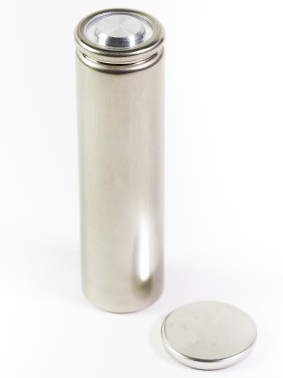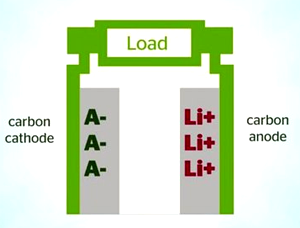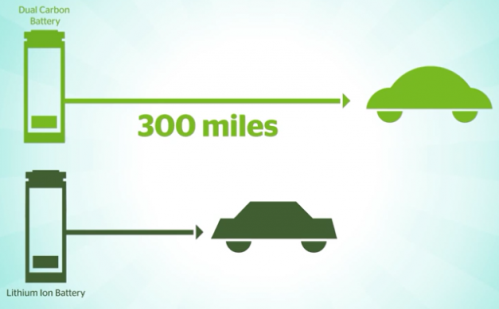Categories: Featured Articles » Interesting electrical news
Number of views: 22973
Comments on the article: 1
Carbon batteries replace lithium
 Since 2014, the US-Japanese company Power Japan Plus, engaged in the search and development of materials for high-performance batteries, has launched the production of a new type of battery. Scientists from Kyushu University took an active part in the development. These batteries basically have an organic electrolyte, which, however, works with a cathode and anode made from a carbon-based composite, and carbon for the batteries is made from cotton, coffee beans or bamboo.
Since 2014, the US-Japanese company Power Japan Plus, engaged in the search and development of materials for high-performance batteries, has launched the production of a new type of battery. Scientists from Kyushu University took an active part in the development. These batteries basically have an organic electrolyte, which, however, works with a cathode and anode made from a carbon-based composite, and carbon for the batteries is made from cotton, coffee beans or bamboo.
The new batteries are called Ryden (Ryden dual carbon battery). Unlike popular today lithium ion batteries, dual-carbon Ryden batteries are the most effective and completely environmentally friendly. Rare and heavy metals are not used here, so the batteries are not expensive and are completely recyclable. This is currently the best way to store electrical energy.
If you look at the lithium-ion batteries, originally created in 1991 by Sony Energitech, they, of course, have significant advantages:
-
quickly recharge and slowly discharge;
-
have low self-discharge in the region of 10%;
-
able to power the widest range of devices, from mobile phones to sophisticated spacecraft.
However, lithium, despite its light weight and good specific energy density, also has disadvantages: a carbon footprint, toxicity, high cost, and scarce components. These shortcomings of lithium prompted researchers from Japan to look for less toxic alternatives, with less risk to the environment, with the possibility of easy disposal.

The specific capacity of dual-carbon batteries is comparable to lithium-ion batteries, but in terms of safety, the new batteries are significantly superior to lithium ones. In addition, new batteries retain their working life much longer and recharge faster, which makes them a great alternative today.
In the summer of 2014, the Taisan Team tested new batteries on an electric racing car, and the results exceeded all expectations. The lightweight Ryden battery did not overheat during the race, and the driver generally did not need to stop or slow down when the battery reaches a dangerous temperature. That is, the battery based on the "double carbon" bulky cooling system is not required in principle.

The manufacturer, of course, does not disclose all the subtleties regarding the battery device, however, it claims a unique chemical process that proceeds between the anode and cathode made of ordinary carbon itself. At the same time, the battery is chemically completely stable and not dangerous, like lithium-ion, neither for the environment, nor for humans.
Tests meanwhile showed a charging speed of 20 times the charging speed of lithium-ion batteries of similar capacity! The rated voltage of one cell is 4 volts. The working life is 50% higher than the best lithium analogues - 3000 against the previous maximum achievable 2000 charge-discharge cycles.

The production of dual-carbon batteries is not associated with a change in existing lines for lithium-ion batteries, and due to the lack of rare metals in the list of components, dependence on market prices for raw materials is excluded. Disposal costs have also ceased to be a problem, and the production itself is almost completely waste-free.
Such a colossal technological leap was the result of a compromise that manufacturers and developers came to, they achieved the desired balance, ”said Kaname Takeya, Technical Director of Power Japan Plus in a press release.
Full-scale production of Ryden 18650 batteries began in Okinawa Prefecture. And now safe and effective batteries are available for a variety of applications, ranging from medical equipment to electric vehicles, for which Power Japan Plus can supply components for creating large-capacity batteries so that electric vehicle manufacturers can get the required capacity for self-assembly.

Since 2014, chemists from the University of Oregon have been searching for an environmentally friendly replacement for lithium. In search of effective bio-material, they discovered a chemical component that could revolutionize the electric battery industry. Cradle to Cradle - this is the name of the concept, which assumes 100% reuse of materials obtained in the process of human life: the product is recreated or a new one is obtained from the source material.
The innovation lies in the disposal of hazardous waste through its reuse in the production of batteries. A team of researchers discovered the possibility of creating cheap reliable batteries from polycyclic aromatic hydrocarbons.
Polycyclic aromatic hydrocarbon (PAH) compounds are contaminants and can be found everywhere. Recycling these compounds will allow you to create sustainable batteries, while cleaning the environment. Being products of the combustion of hydrocarbons, PAHs are distributed through water, soil, air, and are included in the list of the most harmful substances for the environment.
The battery, which was developed at the University of Origon, will contain a carbon anode and a cathode based on PAHs. Of particular interest is the substance coronin. Coronine in solid crystalline form is safe. According to the test results, it turned out that the ion capacity is quite high, the structure is chemically stable, and in the future it will be possible to get batteries that are perfectly suitable for saving the energy of the sun and wind with a view to its further use.

There is a very big advantage of coronine over the same carbon: carbon is incompatible with non-aqueous electrolyte, while for coronin this is not a problem at all! That is, the batteries will turn out to be maintenance-free and at the same time reliable and stable. By the way, studies regarding the formation of stars showed that PAHs are present in the Statue of Liberty nebula, that is, the Sun probably also emerged from the environment containing PAHs - “the energy coming from the stars will be used in batteries, and will come back to us again and again ”Said Hanen Khattab, Ph.D. from the University of Quebec in Montreal.
Obviously, the future is still with carbon batteries. They will be cheap to manufacture, non-toxic, environmentally friendly and for humans. Carbon is widely available. Regular coal contains 80% carbon. Any living or dead organism is characterized by the content of carbon compounds.
Life is impossible without carbon. Plants receive carbon compounds from the air, use carbon to form the root system. Animals get carbon with food. Both of them emit it in the composition of carbon dioxide. One way or another, carbon is not in short supply, and this gives us some hope.
See also at bgv.electricianexp.com
:
